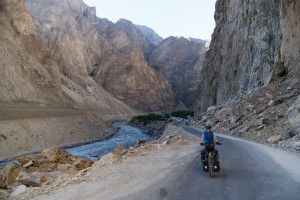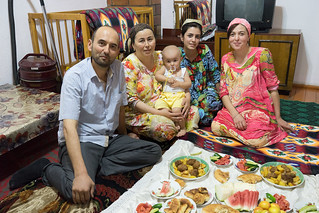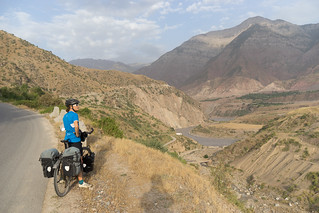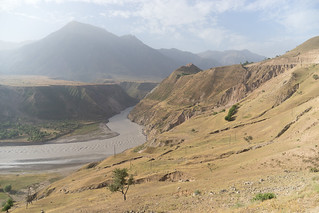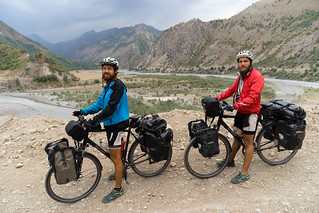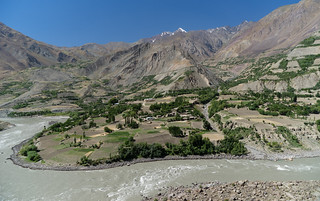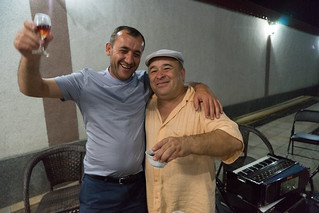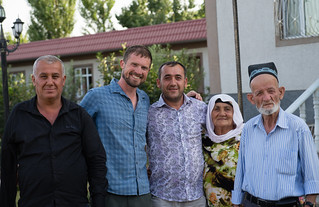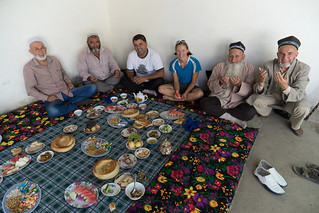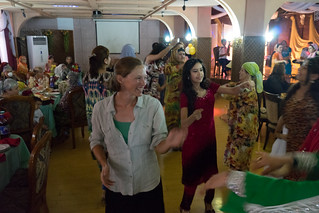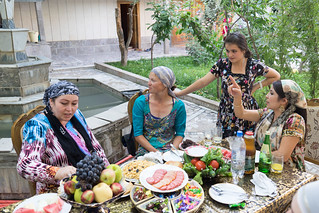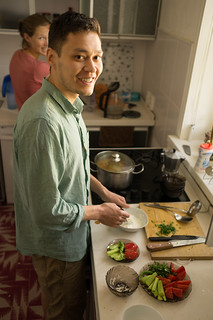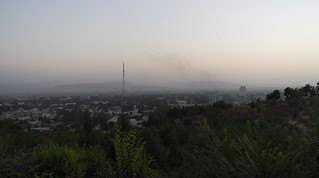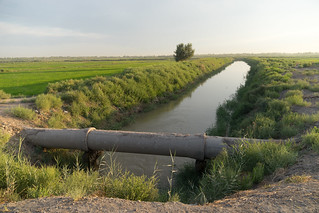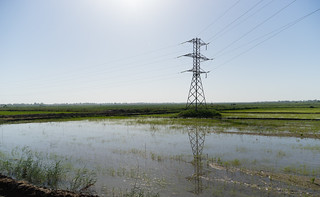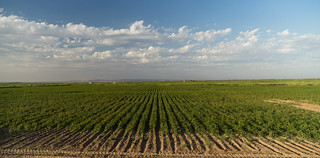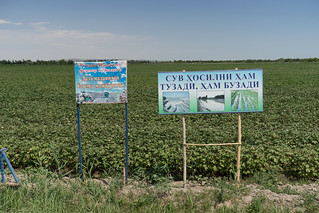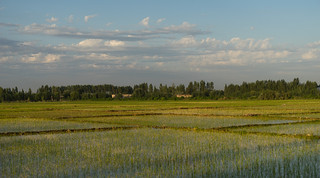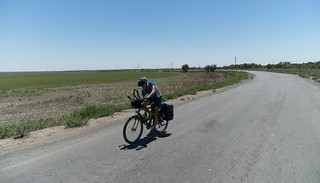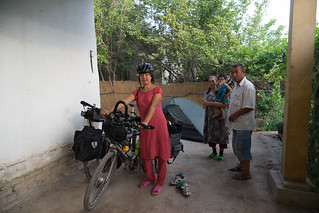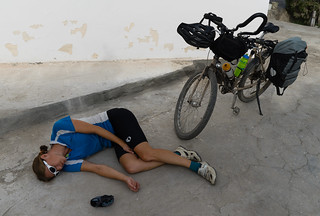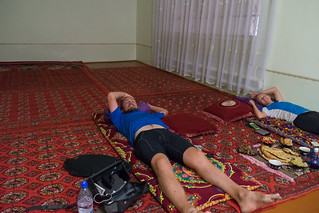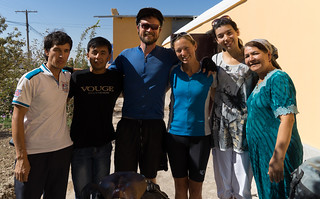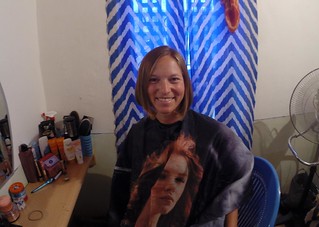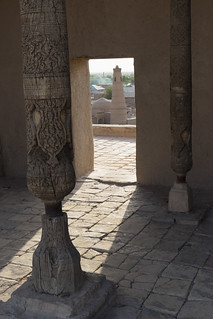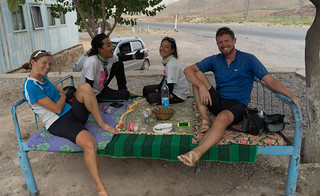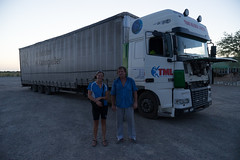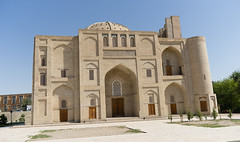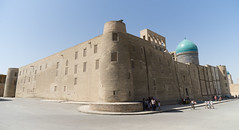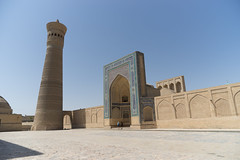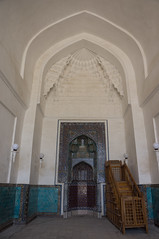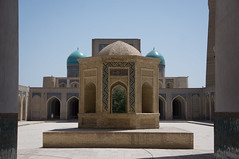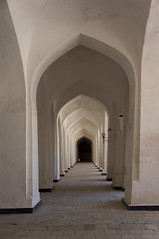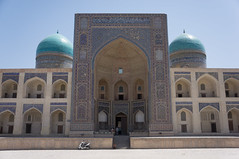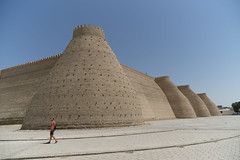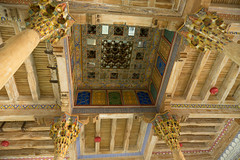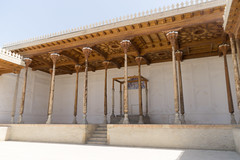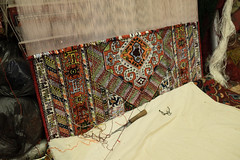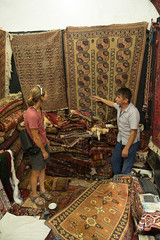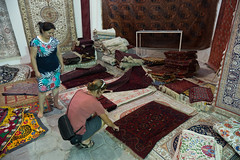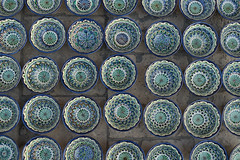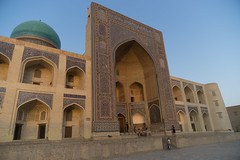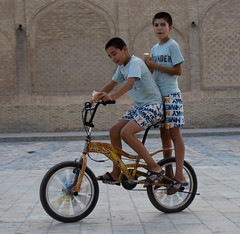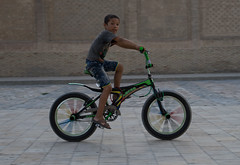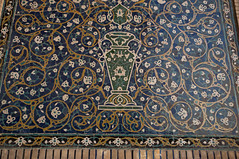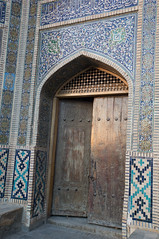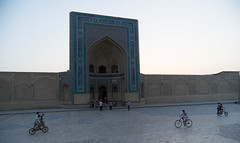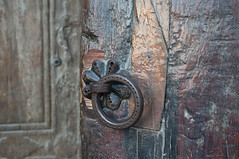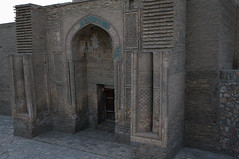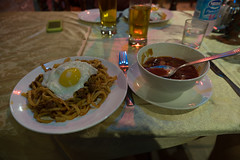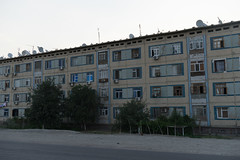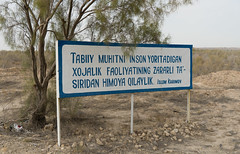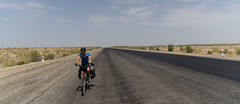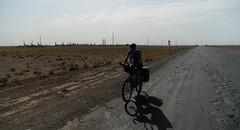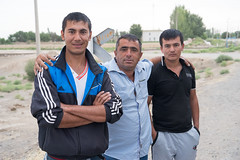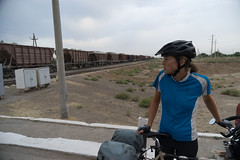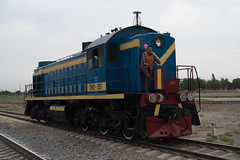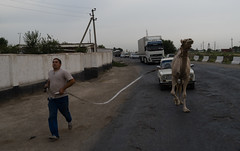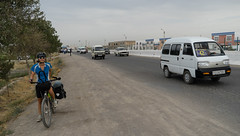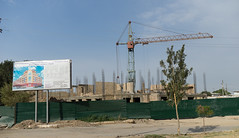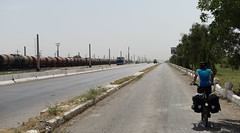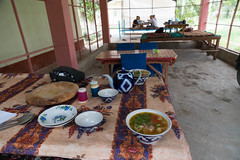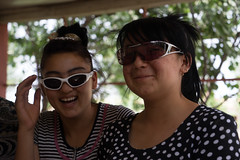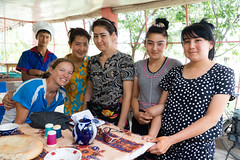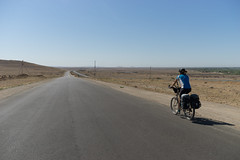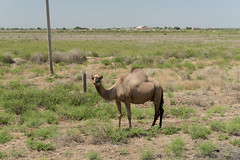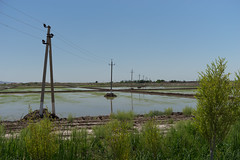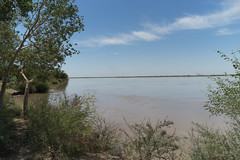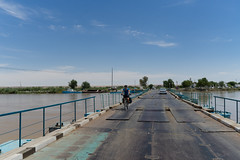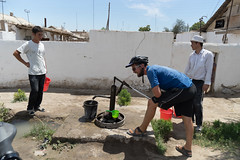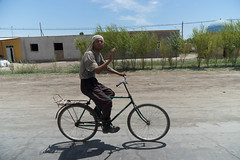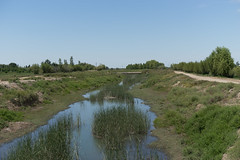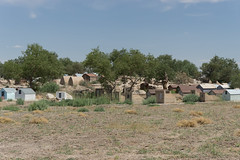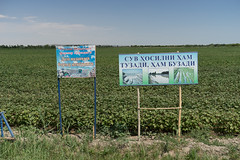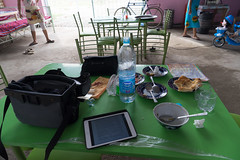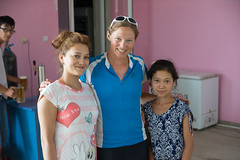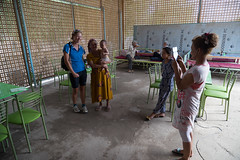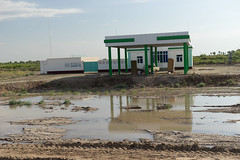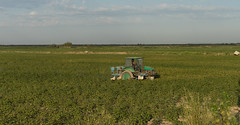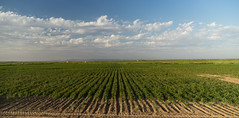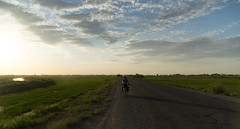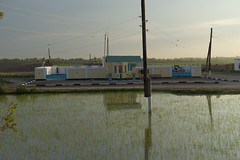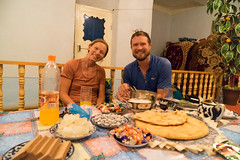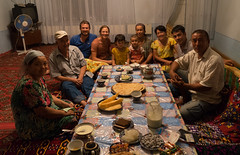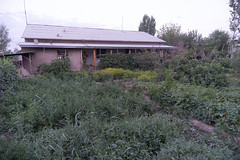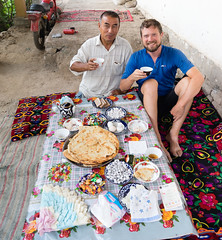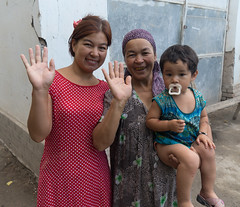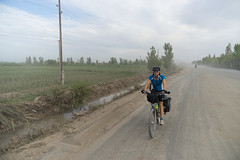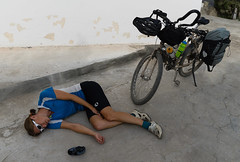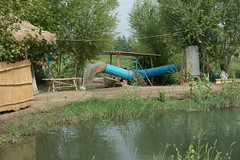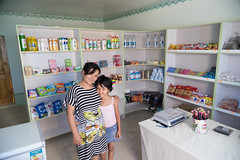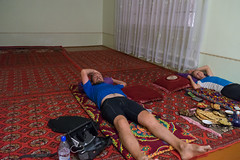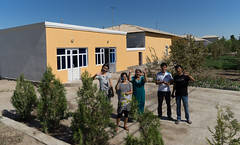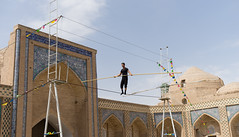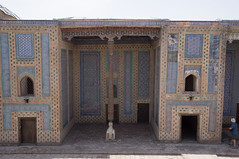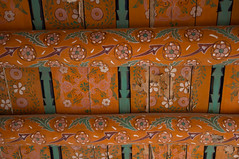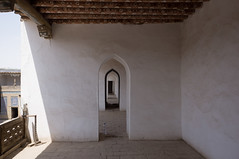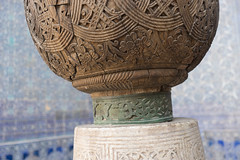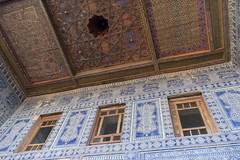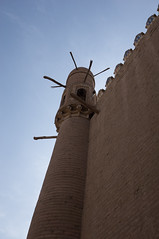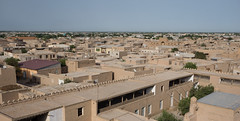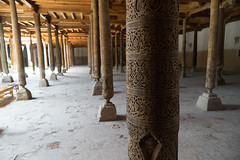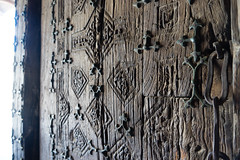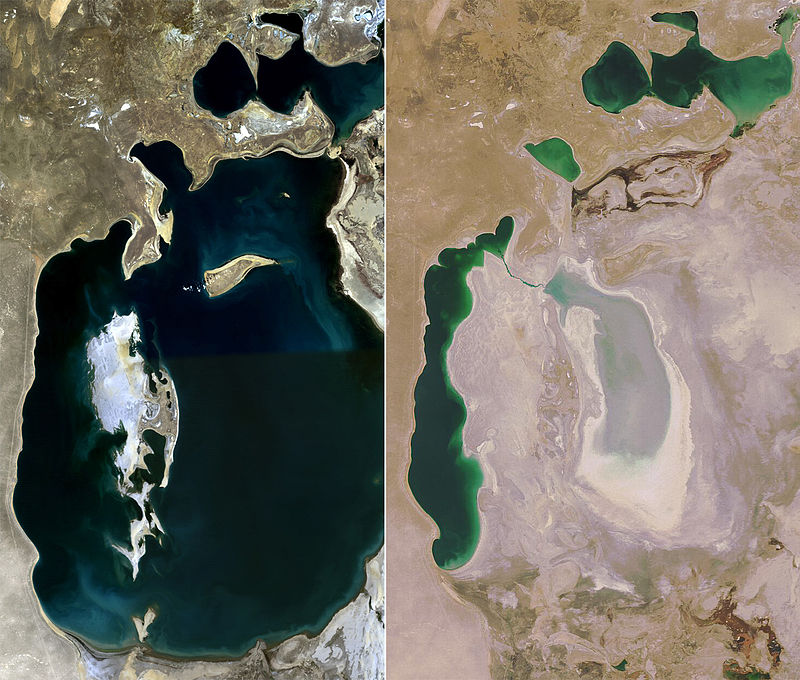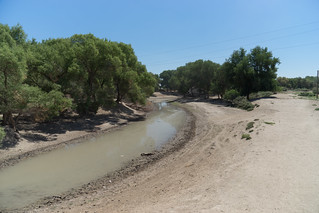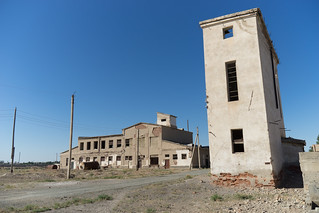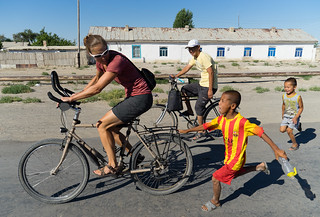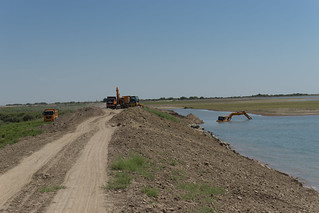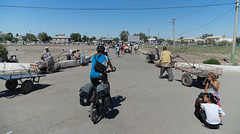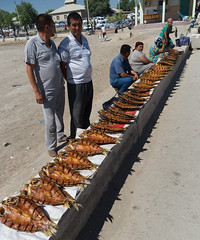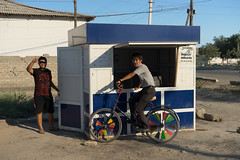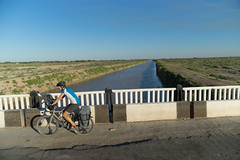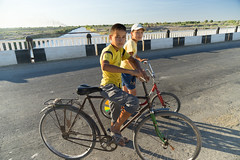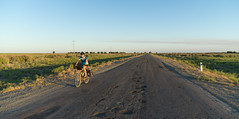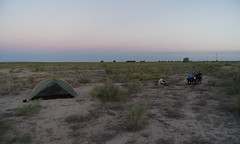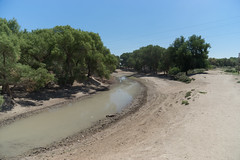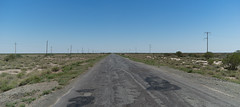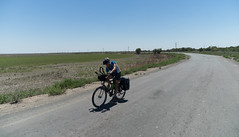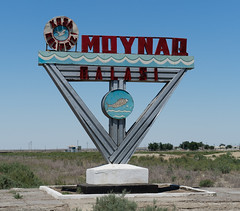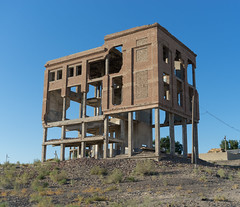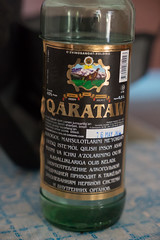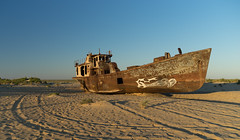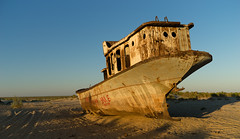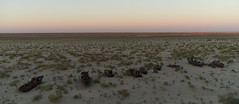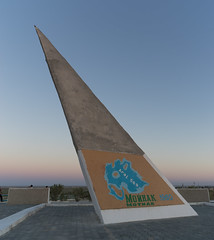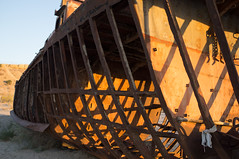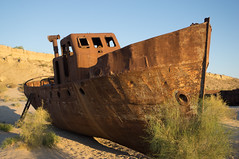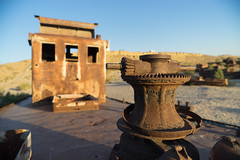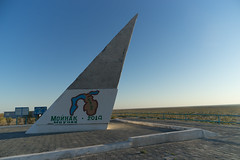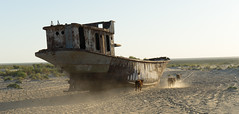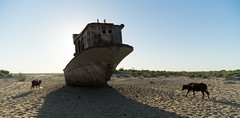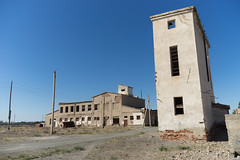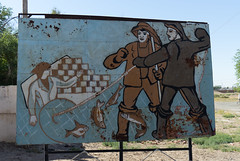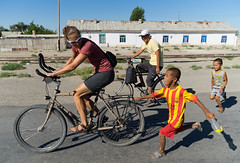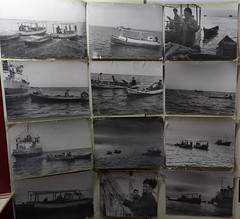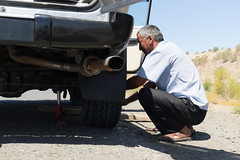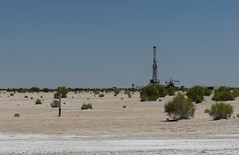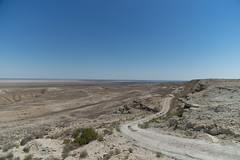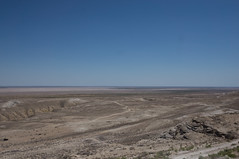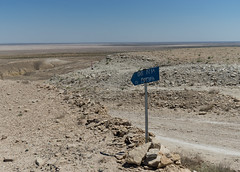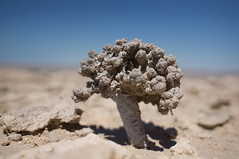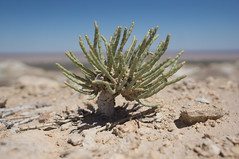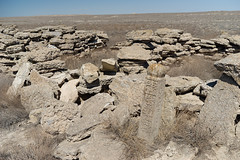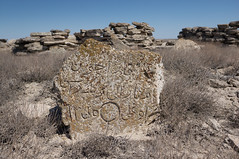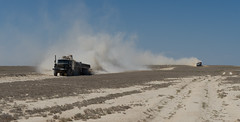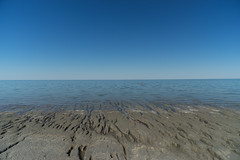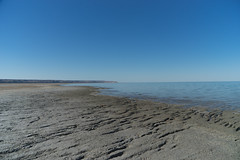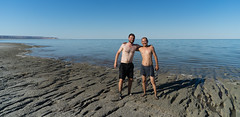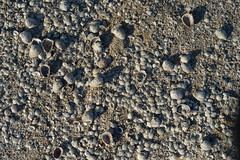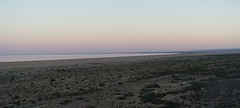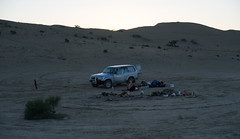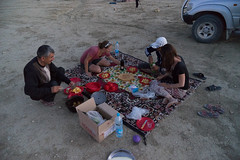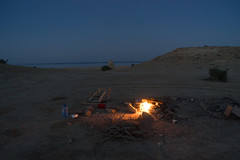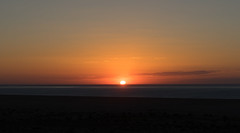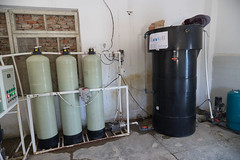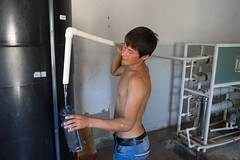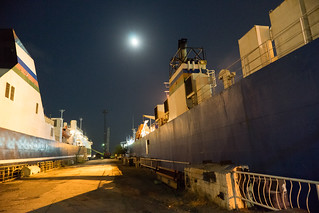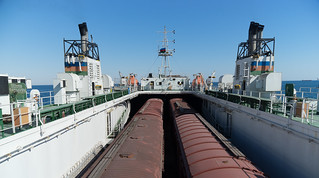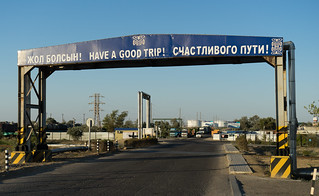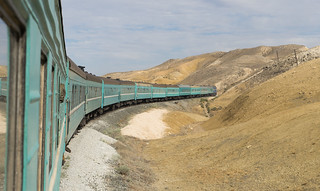We are now leaving Khorog, Tajikistan, and about to cycle through the Wakhan Valley, by Lake Zorkul, and through what may be the most remote stretch of our journey. We are extremely excited. For those of you following us here, realize that we might not have Internet for two weeks or more.
Archive for August, 2014
Into the Pamirs…
Sunday, August 24th, 2014Dushanbe to Khorog – 7 days, 560 km
Friday, August 22nd, 2014For months we had studied the map of Tajikistan and looked forward to reaching Khorog, where we’d start our ride through the remote and beautiful high-altitude Pamir plateau. What we didn’t know was how challenging and stunning it would be just to bike to this town from Dushanbe.
There are two possible routes to Khorog from the capital, and we took the northern one, which is shorter but includes a 3,000 meter pass (sorry everyone, I’ve gone fully metric here in Asia). The first half day of riding seemed normal enough — a paved road following a valley with cotton and other row crops. We left in the late afternoon and spent the first night in a town just 30 km outside of Dushanbe, where yet another family invited us in and fed us dinner.
The next day, the road climbed over a pass and dropped into the first of many canyons. This canyon, carved by the Wakhsh River (a tributary to the Amu Darya), is also the site of the planed Rogun dam, which we’ve heard many people talk about in both Uzbekistan and Tajikistan. It was originally planned by the Soviets in the 1970s, and construction started decades ago, only to be halted. Now the Tajiks are planning to build the dam, which will, when completed, be the world’s tallest earthen dam at over 300 meters (1,000 feet) tall.
Interestingly, unlike in Turkey, where people had very mixed opinions about the country’s zealous building of new dams, in Tajikistan almost everyone we’ve talked to is in favor of Rogun Dam. Currently, most of the country’s electricity comes from a single reservoir. Because natural gas is in short supply, most people in the cities heat their homes with electric heaters. In the winter, because the single reservoir cannot produce enough power, there are rolling blackouts. Everyone we talked with in Dushanbe complained about this. They want more electricity.
The dam will flood what is a spectacular valley and force thousands of people to abandon their homes. In one of the villages that is located near the dam, but that won’t be flooded, I asked if people thought the dam was good or bad. The three people nearby said “karasho,” or “good” in Russian. On the other hand, in one of the small villages that will be underwater, the two people I asked said the opposite.
In Uzbekistan, the few people we talked to about it said the dam should not be built. One person said it was seismically unsafe. The president of Uzbekistan opposes the dam, and he has even threatened war if it is built. Uzbekistan worries that the precious water of the Amu Darya will be held back by this dam, and less will reach the country to irrigate its cotton.
I feel very differently about this dam than the ones I saw in Turkey. I have incomplete information, but I think it probably should be built — Tajikistan needs more energy, and this dam will provide a lot of it without producing much carbon dioxide. It’s sad that people’s homes will be flooded; I hope they are well compensated. Currently, a World Bank study is sorting out the details, and will provide recommendations as to whether the reservoir should be built.
As we rode further up the canyon, the road quality deteriorated, alternating between pavement and dirt. Then a bridge led us across the river and the road followed a tributary. Soon we were on a dirt road between steep rock walls, where we suddenly felt far from civilization. A thunderstorm passed by and we donned our rain jackets for the first time since Georgia.
We spent the night at a mosque with five other cycle tourists — three from Spain and a couple from France. After seeing almost no cycle tourists during our previous three months of travel, we have now seen a few almost every day since leaving Dushanbe. The more we ride here, the more we understand why so many others have decided to as well. The next day, we followed the road as it climbed up several hundred meters and stayed with the Spaniards at the home of a family in a small village at about 2,400 meters in elevation, tucked in a fold in the green mountain slopes. From there, we followed the dirt road over a 3,000 meter pass, and then dropped into a steep canyon, joining the main road to Khorog.
For the next three days, we followed the Panj River upstream – this would be the ride’s highlight. The Panj forms the border with Afghanistan and cuts through a canyon with rock walls rising thousands of meters above the river. There was something almost magical about peering across the river, no more than a few dozen meters wide in places, and seeing the far-away-land of Afghanistan. The road on the Afghan side was always dirt (if it existed), and the towns clearly less developed than the (also poor) Tajik villages we rode through. We saw children running and waving to us, heard an imam give the call to prayer, and watched people threshing wheat. At one point, we watched an elderly couple use a rope to climb from one section of the trail to another that ran far overhead, as the terrain couldn’t support a continuous path. The road on our side was intermittently paved and passed through a small town about every 15 kilometers. Traffic was extremely light, although occasional tractor trailers, carrying goods from China to Dushanbe, passed us.
We spent a night camped above the road peering across at the steep canyon walls, and then another night on the porch of a family we met, who shared soup, bread, stories, and vodka with us. Now we’re finally in Khorog and getting excited for the road ahead. If the ride to Khorog has only been the warm up, we can’t wait for what’s next.
To Dushanbe
Thursday, August 14th, 2014After all the stress about getting out of Uzbekistan, we were relieved to finally be in Tajikistan. We crossed the border in the mid-afternoon and rode until early evening, when we found ourselves in a small town just before sunset. We stopped at a gas station to get water, and realized that we wouldn’t be able to get out of town to a place where we could camp before dark. The station manager spoke a little English, so we asked him if there was somewhere nearby where we could put our tent. He gestured vaguely up the road and we were about to go try our luck when a middle aged man in white leather dress shoes, stylized jeans, and snappy suspenders over a white shirt, topped off with sunglasses pushed up on his forehead under a white golf cap, bounded out of the station’s mini market. “Hello!” He boomed! “I am Rustam! You need help?!” His English didn’t go much farther than that, but in under a minute he scoffed at our camping plans and said the magic words: “My dom, sleep. Come.” The manager supported this plan and pointed to a nearby radio tower. “He lives right there. 500 meters away.” So we hopped on our bikes and followed the white Land Cruiser down the torn up street and into a nearby neighborhood.
Every once in a while the car would stop and one of the men inside would lean out and holler enthusiastically in Russian. We turned onto smaller and smaller streets and at one point were stopped by a little boy waving a toy gun. Rustam’s sidekick – Oskar – jumped out of the car and showered the boy with kisses. “My son, Hassan,” he said in Russian. He picked Hassan up and plopped him on my rack without warning. The bike nearly fell over, so fortunately Oskar was still holding Hassan. He handed me the toy gun, then set Hassan on David’s rack. David, in turn, handed Oskar his camera and showed him how to video. So that is how we rode the rest of the way to the house – Oskar with David’s camera, David with Hassan, and I with Hassan’s gun. Soon, we pulled up under a grapevine-covered arbor outside of a large walled compound. The men leapt out and led us inside. “Moy dom!” yelled Oskar. It was palatial – a large courtyard with a fountain was surrounded by two walls of rooms with a giant three story house on the third side. A large evil eye looked down from above the door. We were brought inside and given a tour. The house contained room after room decorated in sparkly wallpaper, with ornate light fixtures and draperies, but relatively little inside.
We learned later that Rustam and Oskar had been fighting over who would host us – Oskar won that night and proceeded to fete us in a way that made us feel spectacularly welcomed to Tajikistan. There were towers of snacks – candied almonds, dried apricots, walnuts – accompanied by several bottles of vodka and eventually a meal of potatoes and meat. Later, a stout smiling man entered the courtyard, pulled out a harmonium, and proceeded to give us a private concert – the grand finale of which was when he played a tune and I was required to sing along. I made up a song as I went (thank you, vodka), the only words of which I remember now are “It’s our first night in Tajikistan…” At some point in the night we were informed that we would be staying for “at least 3 nights.” We compromised and spent the following day at Oskar’s before moving to Rustam’s for a 2nd night. We really enjoyed our evening there with Rustam and 3 of his 5 daughters – the oldest spoke fairly good English, and we enjoyed practicing Russian (me) and English (her). We had a delicious meal outside under a canopy of grapevines, and at some point Rustam called a relative who speaks perfect English. Over the phone, we were informed that we were invited to a circumcision ceremony for another relative’s son in Dushanbe the next day. We accepted, feeling honored, and then went to bed on mattresses in a spare room.
In the morning the three girls walked us to the main street and we then rode the remaining 20 km to Dushanbe. We were in a bit of a hurry since we didn’t want to miss the ceremony and associated party, but we were held up when we accidentally stumbled upon a funeral feast and were invited in. We were looking for bread and wandered through an open gate towards what looked like a market or restaurant. The men near the entrance waved us in, but we hesitated since we realized it was in fact rows of tables covered in bread and fruit. However, an older man strode up to us and, in English, said “Welcome! Please come in and eat!” He explained that a respected teacher had died last year, and this was the traditional feast that takes place 9 months afterward. “Join us!” he said. “Are you sure? We are strangers…” He wouldn’t take no for an answer, so we sat down with him and accepted the bread he offered. Suddenly a man behind us started praying, and everybody cupped their hands below their faces until he finished. We followed suit, having seen this in Uzbekistan as a sort of grace after finishing a meal. In this case, the prayers occurred several times but people kept eating after, so we did the same, especially when steaming plates of plov were brought out for everybody. The English teacher – as the man who had invited us turned out to be – was not camera-shy, and he urged us to take pictures of him, everything, and everyone – including the imams on the raised platform behind us. I was still in my cycling shorts and, after he led me up to the platform and positioned me between several bearded old men for a photo, I realized that I was the only woman there. This was a common enough occurrence, and nobody seemed to blink at my spandex and exposed legs and hair, but I felt a bit out of place. Nonetheless everybody was warm and welcoming, and we couldn’t believe how much hospitality we had already been shown in only 3 days in Tajikistan.
We eventually made our way out, since we had another ceremony to attend, and biked the rest of the way to Dushanbe. With the help of Bactiyar, Rustam’s English-speaking relative, we found the site of the party we’d been invited to. It was actually a women’s event – the men’s event had been held in the morning – but they made an exception for David (he finally experienced a bit of what I’d been feeling all the way from Turkey, as nearly the only man in the room!). The boy’s father and grandfather were also in attendance, but it was a nice change to be in a room full of women, all laughing, eating, and dancing. It did mean, though, that when it was time for honored attendees to give speeches, I had to give a speech! As foreign guests – who the hosts had only just met – we were considered special enough to stand in front of the crowd and say… whatever we wanted, I suppose. I was dragged up with no warning. Bactiyar’s 12-year-old son translated for me (Bactiyar works for the UN in Nairobi, so his whole family is fluent in English) as I stumbled through a little speech about how honored we were to be included in such an event. Later I realized I probably should have given some advice or congratulations to the little boy whose party it was, but I think I can be forgiven for not having a lot to say on the subject of circumcision!
We were invited to the family’s home for the actual ceremony, which I declined to witness but David was asked to video. It really was an honor to be taken in so completely – they insisted we spend the night and gave us several gifts, including proper Tajik clothing for me. We ended up staying several days in their lovely compound on the outskirts of Dushanbe, where several families all live together, each in their own quarters surrounding a big courtyard with grapevines and fruit trees. We ate every meal outside and were able to communicate fairly well thanks to another of Rustam’s daughters, Parvona (who is married to one of the uncles of the boy), speaking some English and everybody making a big effort to get points across in a mix of Tajik, Russian, and English. I learned to make plov (well, I was allowed to be in the kitchen while Parvona and Madjudah, the little boy’s mother, made plov), we all shared pictures of travels, and we just relaxed and appreciated having landed there in Dushanbe with this fun, welcoming, and high-spirited family. We couldn’t stay forever, though (well, maybe we could have), and after another night we were off to our next home with Said, a friend of our friend Harpreet who used to live in Dushanbe.
We spent most of our time at Said’s feverishly researching our route, as we didn’t have any firm plans after crossing Tajikistan. We had originally hoped to take a fairly direct route to Nepal through Western Tibet, but we had learned that independent travel in Tibet was virtually impossible. We had decided that for the sake of the project, we should visit Beijing, since China is now the world’s largest emitter of greenhouse gases and is also projected to suffer serious impacts, particularly with respect to water supply. So we started reaching out to contacts there, as well as sending a flurry of emails to tour operators in Tibet, since the only legal way to cross the region is with a guide and driver (yes, even if you are biking, you must pay somebody to drive a jeep along with you). We still haven’t decided how we will get from Beijing to Nepal – neither flying nor commissioning a jeep are very in line with our project, but biking the Ganges and the delta in Bangladesh have always been key components of both the trip and the project, given the exacerbated flood risks both areas face with climate change, and Tibet is one of the few land routes to get there.
Aside from fast wifi, we enjoyed meals and conversations with Said, who is about our age and indulged our desire to talk about Tajikistan’s history and present, and also watched movies with us in the evening, something we hadn’t done since leaving San Francisco. We also spent a few nights with a Warm Showers host, Christine, who is from France and works for a development agency in Dushanbe. Coincidentally, Christine had just come back from some time in the mountains north of the city, where she was interviewing people about climate change. She shared what she had been learning, which was that people in the villages have noticed warmer weather and less water. This is a problem for agriculture, but, as we also observed later in the Pamirs, agriculture isn’t the basis of the economy – most families have somebody working in Russia and sending money home.
After over a week in Dushanbe, where we had been very productive but were missing our bikes, we finally rolled out towards the Pamirs, which we had been anticipating since the very beginning of this trip.
Water Use in the Amu Darya Floodplain
Wednesday, August 13th, 2014After visiting the Aral Sea and learning about the impacts of its near-disappearance, we decided to travel along the Amu Darya, one of its two former sources, in order to learn a bit about where all the water goes now.
In Nukus, about 200 km south of Muynak – the town that used to be on the shore of the Aral Sea – we met with Izzet, a civil engineer who works as a professor in Nukus and helps run an NGO dedicated to protecting the Aral Sea. Then we biked another 200 km along the Amu Darya to Urgench, via the ancient Silk Road city of Khiva, and met with Inna Rudenko, who helped form and now manages a group of academics doing research and outreach to improve land and water management in the region. From these two meetings, we learned about some of the major problems with water and land use in Uzbekistan, as well as potential solutions. (Of course, in such a short time we were only able to scratch the surface of this complex issue, and there is much more to learn.) As we biked, we also observed a stark contrast to the former Aral Sea shore. While Muynak was parched and dusty, the towns we passed through between Nukus and Urgench were lush and green. The streets were lined with cotton and rice fields with water ponding between the rows, and each home we visited had a large garden with small canals running through them. It was cooler – though still scorchingly hot – near the canals, and leaky pipes spraying water into the air were everywhere.
As is the case anywhere in the world, land use and water management are tightly linked. In Uzbekistan, water management and agricultural practices follow the patterns established by the Soviet Union, which collectivized farms and set quotas for major crops such as cotton. While water from the Amu Darya had been used for centuries for irrigation, diversions increased dramatically as the Soviet Union turned Central Asia – especially Uzbekistan, south Kazakhstan, and parts of Tajikistan – into a major cotton-producing center. Irrigation is generally done by canal and relies on gravity to distribute water to and across each field. These canals are very rarely lined, and up to 40% of irrigation water is lost to the water table due to infiltration.
In addition to the water used to irrigate crops during the growing season, farmers ‘flush’ their fields several times each year before planting.This involves sending water across the empty fields to pick up salts and toxins in the soil and carry them away. While most fields require this, it is rare for a farmer to know just how contaminated his field is, and therefore how much water is actually needed to effectively remove the toxins. Therefore, many farmers will use as much water as is available, sometimes flushing their fields up to three times. This causes an enormous amount of water waste and water pollution, and until recently also had the effect of routing toxins back to the canals and downstream, as the water used in flushing would be returned directly to the canals at the other end of the field. In the past several years, a World Bank project has built a sewer system to collect the wastewater and keep it separate from the canals that feed downstream fields. Instead, the water ends up in lakes constructed in the desert for this purpose. Apparently people fish in these lakes, and the concentration of salts and agricultural chemicals isn’t dangerously high, but I have trouble believing this.
Taking a step back, we see that this inefficient water use is just part of a much bigger problem: the countries that the Amu Darya flow through don’t see eye to eye on water issues. The river’s headwaters are in the mountains of Tajikistan and Afghanistan, and it flows through a part of Turkmenistan – whose constitution states that all waters in its territory belong to it – before re-entering Uzbekistan. While the five Central Asian countries have formed an organization, the Interstate Commission for Water Coordination (ICWC), to manage transboundary waters, the interests of the individual countries are often at odds. Tajikistan, which faces serious electricity shortages every winter, is planning to build a dam in the Pamir Mountains that would be the tallest earthen dam in the world, and Uzbekistan is worried that this would cut off their water supply. During Soviet times, heating fuel would be shipped from Uzbekistan to Tajikistan in the winter, and in return Tajikistan would refrain from running existing hydroelectric plants so Uzbekistan would have enough water in the summer. This coordination broke down after the Soviet Union collapsed. Meanwhile, during Soviet times a canal was built across the desert in Turkmenistan to divert Amu Darya waters for cotton production – 60% of water in this canal evaporates or infiltrates before it reaches its destination. Afghanistan is currently using less water than envisioned in an agreement reached during Soviet times, but if the country stabilizes and starts to develop, its water use will increase. Finally, projections indicate that climate change will affect the water balance in the region, with more precipitation falling as rain – meaning it would not be held in the snowpack to be released during the summer months, as currently is the case – and melting glaciers, which could increase river flow in the short term, but decrease it in the long term.
It seems clear that farming a thirsty crop such as cotton in the desert isn’t sustainable, but farmers do not pay for water, so they have very little incentive to use it carefully. As we learned, the government plays a very large role in farming in Uzbekistan. They own the land, and farmers sign contracts to lease the land and grow a specified crop (usually cotton) for a certain period of time, up to 50 years. The government provides detailed instructions for how to grow the crop, and a production quota is determined. Seeds and other inputs are all purchased with government credit, and water is delivered to the fields on a schedule determined by the government. When the crop is grown, the government buys it from the farmer and it then goes through processing before being sold on the international market.
We had read that people were forced to pick cotton in Uzbekistan, and we asked a number of people about it. They told us that as high school students they were required to pick, although it appeared that one could get out of it if well-connected. One person told us that they were paid, but that she ended up losing money because the money she earned wasn’t enough to buy lunch out in the fields. Another boy told us it was fun, because he and his friends got out of school when it was picking time. We had also read that the government buys cotton at a much lower rate than they sell it for, but when we asked Inna she said that farmers received a fair price, and that the value on the international market reflected processing that occurred within the country.
If a farmer fails to produce the quota, he may end up buying surplus from other farmers – at a marked-up price – to then include with his harvest at the government rate. Since the land has become degraded in many parts of the country – 20% is degraded in Khorezm, and 100% of the farmland in Karakalpakstan is degraded to some extent – it can be difficult to meet the quota. The solution, other than buying from neighbors, is to demonstrate to the government that the land is degraded and therefore the quota cannot be met. This involves a lengthy process with inspections and piles of paperwork, so farmers are reluctant to initiate it.
Given the damage caused by this large-scale cotton production – the disappearance of the Aral Sea, degradation of the land – and the possibility that water availability will dwindle in the future, due to climate change and the construction of a dam upstream, many believe that Uzbekistan should stop growing cotton completely. However, cotton is hugely important to Uzbekistan’s economy. Not only are large portions of the country’s land devoted to it, but everything is set up for this particular crop: farmers know how to grow it, machines are available to plant, tend, and harvest it, gins and other processing plants are set up to process it (and extract value from every part of the plant such as its seeds), credit is available, and all of the trade links are set up to sell cotton. As an example of cotton’s importance, during our ride we were waved over by a group of men repairing a canal. They showed us the cotton plants, which were just flowering, and when I mimed picking cotton and asked if it was difficult, they just smiled and said one word: ‘dollars!’
So, will Uzbekistan continue to grow cotton until the water is gone and the land is all degraded? What are the alternatives? Already, the country is heavily dependent on remittances from abroad – many men seek work in Russia and Kazakhstan, and 16 percent of the country’s GDP is from money they send home. Inna’s group conducted research and pilot projects to investigate ways to make cotton farming more efficient and less environmentally damaging. One promising approach is to line canals with plastic; while cement is cost-prohibitive, using plastic can pay off in two years – not through savings in water costs, of course, but in additional profits where water currently doesn’t reach some parts of a field due to infiltration. Drip irrigation has also been introduced, and while this is more practical for vegetables, there are cases where it has been used successfully for cotton.
Field preparation and the location of specific crops also makes a difference. Where fields are not level, water can get backed up and not reach crops that need it. Planting less thirsty crops at the far end of the field away from the canal can also help make sure the most thirsty crops – namely, cotton – are planted upstream and are most likely to receive water if there is a risk it won’t reach the far end of the field (due to infiltration, evaporation, or insufficient water released into the field). Another approach to save water is to use a device to measure soil salinity. These measurements can show where flushing is necessary and help farmers determine the appropriate amount of water to use in each section of their fields. The device is expensive, but the group has proposed ways to share it among farmers. Finally, for land that is too degraded to produce cotton, the group has found that a certain type of tree can tolerate these salty soils. This tree produces useful products such as firewood and timber for building, so where farmers have lost land for cotton production, once they have convinced the government of their predicament, they can at least get some value out of the land.
Learning about these projects made us hopeful, but ultimately the situation seems unlikely to change dramatically as long as the current governance and market system is in place. Nobody expects the Aral Sea to be refilled, but there are at least a few people working to protect what is left and to keep the Amu Darya flowing.
A Journey Across Uzbekistan
Tuesday, August 12th, 2014After 24 hours on trains, we were so happy to be on the road again. Our plan was to bike to Moynak, a town that used to be on the edge of the Aral Sea, visit the sea, and then follow the Amu Darya River upstream. From the Kungrad train station, we biked a couple of hours before making camp behind a slight rise near the road, had our usual pasta dinner, and turned in. The next day we continued to Moynak. We were surprised at the amount of green as we biked, made possible by irrigation canals off the Amu Darya and a high water table. There was less and less green as we traveled north, though, and as we neared Moynak it was a fairly desolate brown-gray in all directions. We also saw what we thought were dust storms, but was mostly smoke from burning the little plant life that grows around town in order to create better pasture.
From what we had read, we expected a totally bleak, lifeless ghost town to greet us. We were surprised when we stopped to buy a drink near the bus station on the outskirts of town, to find a reasonable amount of activity – women and children waiting for martrushkas (small buses) into and out of town, a few stalls selling snacks, and a couple of small shops and cafes. Not exactly hopping, but not dead either. We found the one hotel in town and met Lhamo, another traveler our guide had found who joined us for our tour to the Aral Sea, bringing down the cost and adding a fun new dynamic to our traveling team.
We loved visiting the Aral Sea, even though we know it is the site of one of the world’s worst environmental tragedies. To see more about this trip, see this blog post.
After our two-day jeep trip to the Aral Sea, the driver dropped us off in Nukus, the capital of the province and autonomous republic of Karakalpakstan (Karakalpakstan has its own language – Karakalpak – which is closely related to Uzbek and Kazakh. Schools are taught in this language, and no one we talked to suggested there was tension around this different ethnic group and language, unlike what we encountered in Kurdistan). We had planned to start biking towards Khiva that evening, but I remembered that we had a contact for our project in Nukus. We checked our email, and our contact had responded to our earlier message with a phone number. We called, and half an hour later he was sitting with us in the cafe of the hotel where we’d been dropped off, telling us about his work on water management in Karakalpakstan. Check back soon for a post on water management in Karakalpakstan and the nearby district of Khorezm.
From Nukus, our plan was to bike southeast through Uzbekistan, visiting Khiva and Bukhara, and maybe Samarkand and Tashkent if we had the time. I was feeling giddy as we set out in the morning, happy to be back on the bike and making forward progress. We stopped for lunch at a small chaihanna (spellings for this word, which means tea house, change from region to region, so I’m just going with the most phonetic English spelling) – the family that ran it was sweet and got out their cellphones to take pictures with us. Unfortunately, I think their food may have been less than fresh; the electricity was out (a common enough thing, but maybe in this case it had been out for awhile…), and everything was room temperature. We made it to a small village around sunset and asked around for a place to camp. At a tiny shop, a young man beckoned for us to follow him; he led us to his family’s house, where we were allowed to set up our tent in the backyard. It was a nice combination of privacy and socializing, as we made our own dinner but were then invited into their beautiful home to eat while they had tea. A neighbor who spoke English came by, and David interviewed the father about climate change with his help. As I ate, I started feeling peculiar; I got very hot, and my stomach felt unsettled…
I got in the tent feeling decidedly queasy; I hoped the fresh air through the tent screen and a good night’s sleep would help, but I had barely drifted to sleep when I woke up fighting waves of nausea. I unzipped the tent, wondering if I could navigate the path past the chickens and cows to the outhouse in the dark, and then it passed. I went back to a fitful sleep, only to be woken up by more insistent messages from my stomach. Sitting up to open the tent made it worse, so I worked the zippers with my toes. Something was definitely wrong. I fell out of the tent and managed to crawl a few feet to a nearby canal just in time… very unpleasant, but I felt better and was able to sleep after emptying my stomach of whatever vile thing I’d eaten that caused the problem.
The next morning I felt weak and couldn’t eat anything, but for some reason I thought I could bike the 70 km to Khiva where I could just rest in an air-conditioned guesthouse and then see the ancient Silk Road city I’d read about. It didn’t quite go like that. I was a little worried that leaning over my bike would hurt my stomach, but the real problem was that I had no strength; I had nothing in my system and I was bearing all my weight on my arms to spare my stomach the jolts from the bumpy road. Even with David carrying all of my gear (thanks, David!) I was riding at a snail’s pace. I broke the ride down into 12-km segments; after the first 12, I found a slab of concrete outside an empty-looking building and threw myself to the ground. I was asleep by the time David got off his bike.
It went on like this for several hours, and it got hotter and hotter – David was pouring water over me to help cool me down, but it dried quickly in the 105-degree furnace-blast headwind that was central Uzbekistan in the middle of July, and we stopped every few kilometers to repeat the process. Eventually we limped into a small shop to buy water; we poured ourselves onto the floor and sipped languidly at our drinks while the shop owners looked on in mild alarm. We chatted with them a bit, and they brought over a chair for me to sit in. Another customer invited us to nap in his house, but we waved him off, saying we had to make it to Khiva. After he left, and we still hadn’t budged, the shop owner’s son tried again. ‘Dom?’ he said, folding his hands under his tilted head in the the universal sign for sleep. ‘Khiva!’ David said, still a motionless puddle on the floor in the corner. Realizing that I had nearly fallen asleep as this conversation unfolded, I reasoned that we were actually more likely to make the remaining 25 km to Khiva if we rested for an hour or so and continued on when it was cooler. My brilliant argument won, and we followed the young man to his house, conveniently right next door. We collapsed on mats on the floor in the main room, and woke up two hours later. I felt marginally better and thought we really might make it to Khiva – until David spoke up and told me he wasn’t feeling very well.
The mother came in with tea and cookies and made motions and words that I think meant we could sleep there that night. ‘Khiva…’ I weakly said in response. As the afternoon wore on and neither of us felt compelled to stand up, we realized we needed to stay. I mimed our inability to bike to the son and said ‘palatka?’ (tent), gesturing outside, to ask if we could camp near their house. He shook his head and pointed to the mats we were lying on – ‘You’ll spend the night right there,’ he was clearly saying. So we did. Around 9:00 they served dinner, and this was when I realized David really wasn’t doing well. ‘You go,’ he said. ‘I don’t think I can eat.’ I wasn’t sure that I could eat, either, but I managed half a bowl of soup and a few pieces of fried potatoes. During dinner, I had a nice conversation with the ten-year-old granddaughter of the family, using her book from English class at school. I was re-learning the Cyrillic alphabet when a family member came in and said something that caused a stir. I didn’t understand until they said ‘temperatura’ and wrote down 38.7. This meant nothing to me, but we did the math and realized David had a temperature of 102. I wasn’t sure what to do, but fortunately it wasn’t left up to me. Within 15 minutes, an old man and young woman burst through the doors, wearing scrubs and carrying a metal case. The man sat down next to David and started taking his vitals. He spoke about six words in English and the rest of the time he just yelled jovially in Russian. He established David’s age, took his blood pressure and temperature, prodded his stomach (ouch) and then indicated that David needed an injection. Oh boy. I wrote down the medicines but don’t actually know what they were. We figured it probably wouldn’t do any damage so motioned to go ahead. As they were leaving, we asked how much we owed and were waved off. We’re not sure if it’s a socialized medical system or the fact that the father is a doctor. In any case, I couldn’t believe our good fortune in having ended up there. After that, we slept some more and David’s temperature went down. The next morning we both felt well enough to eat breakfast and interview the mother about climate change.
It was getting late and if we were going to bike to Khiva in the cooler part of the day we needed to leave. ‘Don’t go!’ they said; ‘Stay, and we’ll make you plov!’ Plov – the national dish made of rice with carrots and meat – is generally tasty, but it may have been what made us sick and it was the last thing we wanted at that particular time. I was still eager to get to Khiva, so we thanked them again and biked the last bit to Khiva, though we felt sad about it as soon as we left – they were a lovely family and really helped us when we needed it, and it would have been nice to spend more time with them. However, the riding was great – it was the easiest 20 km I’ve ever biked. Flat, cool, with a tail wind. We found ourselves outside the huge mud walls of Khiva in one hour and four minutes.
We found a guesthouse and set out to find the touristy, edible food we’d dreamed of. Turns out that Khiva, while an obvious tourist attraction, is not fully a tourist town. Everywhere we went had only national dishes (plov, manty (meat dumplings), pungent green noodles made with dill) on their menus, and half of the listed dishes weren’t available. We finally settled on potato ravioli. Starch wrapped in starch! That went down OK, and then I asked the waitress if there was a salon in town where I could cut my hair. She showed me to one, where I proceeded to get the worst haircut of my life – she chopped off about ten inches, which was a few more than I wanted, and it was so uneven that I needed to do touchup with a pocketknife later. Still, I feel it was worth the ten dollars I paid (I was later told I was totally cheated, but it’s the cheapest haircut I’ve ever gotten), and it’s much cooler for the Uzbek summer and easier to deal with in cold, no-pressure showers. David also got some grooming done (they did a better job with him).
We enjoyed a couple of days exploring the tiny, walled-in ‘museum city’ – so many mosques and medrassas – all exquisite, tiled affairs with little museums tucked into random corners. We visited as many as we could before they started to all look alike, and then spent a lovely evening watching the sunset from the watchtower in the Ark – the Khan’s residence back in the day. In addition to the view of the city skyline, we had the distinct pleasure of watching a group of young men film a music video. One guy pretended to play the guitar and dramatically lip synced a song about Uzbekistan while the others ran around him with huge cameras to capture him from every angle. A group of Spanish tourists – almost the only other foreigners in the city – had also come up for sunset, and it was nice to be able to speak Spanish after months of trying to communicate in languages we don’t actually speak.
We stayed an extra day in Khiva since David still wasn’t 100%, and then we biked the 35 km to Urgench where we had set up a meeting with an agricultural economist who works on water and land management in Khorezm, the district around Khiva. We met over lunch – plov again, but this time hot and delicious – in her home, but no sooner had David taken a few bites than he started feeling sick again. We ended up staying two nights in Urgench for him to recover, and I admit I may not have been the most compassionate traveling companion. I tried to take care of him and not be too impatient, but at this point I was feeling stuck in the middle of the country with just over a week until our visa would run out. Even if we were healthy we couldn’t bike the whole thing, and I felt stressed about the road ahead – 400 km of desert to Bukhara, then another 500 to the border. We hadn’t decided whether to visit Tashkent and meet with experts there, and Samarkand had been recommended by everybody but since the border crossing near it was closed, it would be a big detour. We were also concerned about the border itself, since we hadn’t declared everything on the train (it was very confusing at four AM… ) and we’d heard stories of very thorough searches.
In the end, we biked 80 km out of Urgench until the green, irrigated landscape ended and we were in desert again, then hitched a ride with two Russian truck drivers to Bukhara. It took nine hours and every once in a while they would say ‘police’ and close the curtain that divided the bed in the back of the cab, where we were sitting, from the front. There were never any problems though, and in the evening they stopped and fixed us a little picnic dinner. Very nice guys – one had been driving for 35 years – and we wish we spoke enough Russian to have real conversations with them! They dropped us off at a truck stop a few kilometers outside of the city, and we biked in around midnight. It was a nice time to arrive, as it was quiet and cool, but a few people – including a few friendly guys on bikes who joined us for the last stretch – were still up, and a nice, not-too-aggressive guesthouse owner found us on the street and offered us a decent room for $20. We decided to stay there rather than wandering around any longer, and we spent the next day exploring the city.
Bukhara is much more ‘lived-in’ than Khiva and feels a bit more real. The ancient buildings are more spread out and it isn’t completely walled in. First order of business was to get more money, as we were nearly out (tip: there is an ATM that dispenses dollars! It’s near the bazaar on the way from Lyab-i Hauz to the main complex. I was convinced we were out of luck since it was Sunday, the next day was a holiday, and our outdated guidebook said most ATMs didn’t work or would give a terrible exchange rate. When we found it, managed to punch the right buttons in Russian, and Benjamins rolled out, I confess I nearly cried. Uzbekistan was getting to me…); we also needed some tubes since we had no spares after I got a flat on the way to Moynak. Between the errands and an afternoon nap, I’m sure we missed some things in the guidebooks, but we were content visiting a few major mosques, minarets, and medrassas, as well as doing our first souvenir shopping since Diyarbakir. We wandered between the covered bazaar areas, the Lyab-i Hauz (old pool surrounded by cafes and mulberry trees), and Bukhara’s main complex, and when it got cool in the evening enjoyed watching kids ride their bikes and kick a soccer ball around the ancient plaza in front of the main mosque. It was the last night of Ramadan and there was a festive feeling that evening, with families out and about until late.
We got up the next morning and finally started riding towards the Tajikistan border. We’d decided to skip Tashkent and Samarkand since we wouldn’t be able to reach them by bike and really only had time to get out of the country. It took five days to get to the border, riding from about six to noon, napping in chaihannas from noon to four, and then riding until sunset. The first night, we camped in the yard of a big restaurant, and the next night by a small river after biking out of the flat desert and into our first bit of topography (yay!). The following night we treated ourselves to a cheap hotel in the friendly town of Boysun, a bright oasis in a basin between dusty mountains. The roads at this point were lined with girls and women selling apples and grapes – a nice contrast to the ubiquitous melon-selling men that had lined the road since Nukus. There was something comforting about biking up tree-lined hills with smiling, salam’ing girls after the rest of Uzbekistan which was, for the most part, monotonously flat and deserty. There were still checkpoints, but instead of looking at our passports the police usually just gave us melon and asked questions about our bikes and other gear (everybody is fascinated by the rearview mirror on David’s helmet). We also bumped into our first cycle tourists since Georgia – a Korean couple one year and four months into their three-year around-the-world trip. They gave us good tips about the road ahead and got us excited for the Pamirs.
The following day we made it to Denau, the last town before the border. It was too populous to sneak off the road and camp, so we started asking for a place to put our tent. Before we knew it we were surrounded by men, all insisting we come to their house. One called an English-speaking niece – what a relief to hear her say ‘wait ten minutes, I will come for you – I have a big house and you will stay there.’ However, her uncle didn’t stick around to tell everybody what was going on, so we spent those 10 minutes trying to politely explain in our miserable Uzbek/Russian that they were very kind but we already had an invitation to somebody’s house and she will be here soon, we must wait, etc. When she did get there we were being forcibly marched to somebody’s house; we were very happy to follow her to her home, where the family had a mini-party for us and she translated and talked about her life all evening. She had learned English in Dubai, where she’d lived for eight years. Now she wanted to move to the US, or anywhere really other than the small town where her family lived. It was wonderful being able to learn about Uzbekistan from a peer (well, she’s 26), and her family was very kind to us. It was sad, though, hearing about her frustrations with the lack of opportunity she faced.
We left late the next morning for the final stretch to the border. To our delight, we were not searched – our bags were put through an x-ray machine, our medicines received a cursory examination (perhaps cut short because something had leaked and the bag was sticky, making it unpleasant to search), David was asked to explain only 1 piece of recording equipment, and the harshest line of questioning was why we don’t have children. Whew! We were delighted to have made it through after a lot of worrying, and we received a friendly welcome from the Tajik guards as well.
Oh, Uzbekistan – your heat, police presence, and stomach ailments tested us, but we had a lovely last week there and I’m glad we biked the final stretch. I have yet to process the images of never-ending desert from the train (big props to people who bike that northern stretch!); the Amu Darya abruptly ending in the middle of the desert; the Aral Sea and the people who live on its former shore; endless flooded cotton fields; water flowing everywhere, in canals, backyards, and roadsides; the occasional camel on the side of the road (or the middle of it); towering tiled minarets and ancient medrassas; lonely towns in the middle of dusty mountains where old men wave us over for chai and then perform a prayer for our onward journey; green oasis gems with apples and commerce and cheerful women; and of course the families who took care of us when we were sick and told us about their lives. Part of me wishes we could have covered more ground, but being sick forced us to slow down and perhaps experience more even while seeing less.
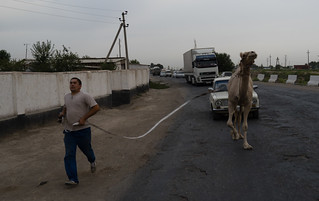
We are now in Dushanbe, the capital of Tajikistan, preparing for the Pamirs and plotting the second half of our trip. India, China, Tibet, Nepal… The borders and restrictions that plague this part of the world are getting us down, but I know our frustration is trivial compared to how all of this affects the lives of people who actually live here. We have lots of exciting route options – we just need to pick one, make sure our visas are in order, and start moving.
Bhukara to the Border: Photos
Tuesday, August 12th, 2014Khiva and the Amu Darya Floodplain: Photos
Monday, August 11th, 2014A Visit to the Aral Sea
Monday, August 11th, 2014When we considered crossing Central Asia in a Ride for Climate, I knew we had to visit the Aral Sea – or at least what remains of it. Even though the sea’s demise wasn’t due to global warming, it’s one of the world’s worst environmental catastrophes, serving an example of how humans can alter the planet. We wanted to visit the sea, meet the people who live near it, and understand if it is truly the cautionary tale we’ve heard it to be.
The Aral Sea was once fed by two mighty rivers, the Amu Darya and the Syr Darya, which flowed from the mountains of Afghanistan, Tajikistan, and Kyrgyzstan into a vast desert, where they formed the Aral. The sea has no outlet – its water levels are determined by the balance between water flowing into it (or falling into it through rain) and evaporation. Fifty years ago it was the world’s fourth largest inland body of water, with a surface area greater than Lake Michigan’s. It contained over a million square kilometers of water – about 30 times the amount of water Lake Mead can hold at capacity. In the early 1960s, more than 40,000 tons of fish were caught annually in the sea.
While people had been using water from the Amu Darya and Syr Darya for centuries to irrigate crops, in the 1960s the Soviets dramatically increased the water withdrawn from these rivers to feed agriculture, with an emphasis on cotton, one of the thirstiest crops. As less and less water reached the sea, its level started dropping. By 1970, the Aral Sea had dropped six feet. As the level dropped, the water became saltier, and fewer and fewer fish could survive. By the early 80s, the fishery disappeared entirely.
When the Soviet Union broke up in 1991, the sea’s water level had dropped 50 feet, and its area was cut almost in half. The newly independent countries where the sea is located – Uzbekistan and Kazakhstan – continued the agricultural practices started by the Soviets, and the sea continued to shrink. Today the Aral is a series of small lakes, with less than one tenth the water it once held. The satellite images below, provided by NASA, show the lake in 1989 and 2008.
After taking the train to Kungrad, Uzbekistan, Lindsey and I biked the 90 kilometers to the town of Moynak, which once sat on the shore of the Aral Sea. Our ride to Moynak intersected with several canals, which appeared to bring a feeble amount of the Amu Darya’s final water to the town. These canals kept the surrounding landscape from being entirely barren – we saw pockets of water and green bushes instead of pure desert. The town itself follows a long road, as it used to jut out as a peninsula into the lake. It was dusty, with a few abandoned buildings, and at the far end sat an abandoned cannery, where thousands of tons of fish were once processed every year.
It was over 100 degrees F when we arrived, and we bought some water at the one store we found, where several of the packaged items we inspected were expired. We struggled to find food to eat in town – there appeared to be only one store (we later learned that there were a number of small stores, but they weren’t labeled, as they aren’t set up for outside visitors). We also didn’t trust the food at restaurants, as the water supply isn’t good, and intermittent electricity means that refrigeration is sometimes lacking. The town has one hotel, which cost $8 per person per night. We had hoped to stay at the one homestay mentioned in our guidebook, but we learned that the police had shut it down (we’re not sure why).
We hired a guide, a man who spoke English and has lived in Moynak his entire life. He told us he didn’t like the criticism his town receives, and that it actually has a good community that supports itself – it isn’t the ghost town suggested by some journalists. Following him around Moynak, we found more stores where we could buy food (and vodka), as well as a treatment station built by the French where people get drinking water for a few hours every day. He also said the population was growing and not shrinking, as it did after the collapse of the fishing industry.
I asked our guide what the biggest problems were in Moynak. He said “water, weather, and unemployment,” in that order. Moynak is literally the last town to get water from the Amu Darya River, and by the time the river reaches town it is too salty and contaminated, as it has already been used by millions of people upstream. As for weather, our guide explained that it was too hot in summer, with horrible dust storms, both of which are a result of losing the sea. And of course, there isn’t much work in the town – the fishing industry collapsed long ago, as did the cannery in town.
In our reading of the literature on the Aral Sea, one topic that comes up over and over is how increased dust from the old sea bed – contaminated with toxins from industrial agriculture – has led to cancer and respiratory problems. Rates of childhood pneumonia are higher in this region than anywhere else in the former Soviet Union. We asked our guide about this, and his response was interesting. He said that yes, there were health problems, but that the media made it sound worse than it was.
One scholarly paper we read listed the health effects of losing the Aral Sea, but then also noted that the most serious health issues “are directly related to Third World medical, health, nutrition, and hygienic conditions and practices.” In other words, while changes in air quality have hurt the population, the biggest problems are the same as those faced by any poor population in the world. However, one major reason for the poverty is that the town has lost its major industry – fishing.
Our guide took us to the highest point in town, a hill that was once a bluff overlooking the inland sea. Stretching out to the horizon was the former lake bed, a flat desert emptiness with a row of rusted boats lining the former shoreline. Our guide told us that this was a holy place: during World War II, soldiers bound for the front lines were bid farewell from that point – and then they sailed north across the Aral Sea. It felt surreal to hear this story and envision parents watching their sons disappear on boats to cross the sea and fight Hitler. Now all we saw was empty desert.
We decided to see what is left of the Aral, so we hired a jeep, and along with our guide and a Korean tourist who also wanted to visit the sea, drove out into the former lake bed. I was surprised to find a paved road, and then pass by gas wells. Apparently, the drying of the lake has made it easier to extract fossil fuels. I asked our guide what people thought about the gas wells. “They’re good,” he said, because they were giving people in the region jobs.
The paved road quickly gave way to a rutted jeep track, and it took three hours on a bumpy road to reach the shore of the sea, where we found ourselves in an isolated, beautiful place in the desert. The water was once one third as salty as the ocean; now it’s three time saltier because the fresh water has evaporated, concentrating the salt (and anything else in the water). We went for a swim after our guide assured us that it was clean enough to do so. Salty water makes you more buoyant, and I almost fell asleep in the water lying on my back. It felt strange to so greatly enjoy a place that I knew was an ecological disaster. That night, we camped on some cliffs overlooking the water, and then woke before dawn to watch the sun rise over the shrinking sea. It was beautiful, sad, and lonely.
The next day, we drove back through Moynak and our guide took us to where the Amu Darya now ends. A dike blocks its progress, creating a lake that collects the small amount of flow that makes it this far. We were told that there are several projects creating such lakes to provide habitat and some opportunities for fishing. A few bulldozers sat idle nearby. A river with an annual discharge about one seventh that of the Mississippi is stopped by a simple dirt wall.
Our jeep drove us to the town of Nukus, where we started biking again, following the Amu Darya upstream. We crossed the river, finding that it had grown in size. And then, as we passed rice and cotton fields, we saw where the Aral Sea has gone. It has gone to agriculture. Whereas Moynak had almost no water, it was everywhere in the upstream floodplain. Families have canals running behind their homes, with verdant gardens in every yard. We’ve heard about many problems with the agriculture that feeds off the Amu Darya – it is hugely wasteful of water, and soil salinization is lowering yields. But after seeing the emptiness of the Aral Sea, it was almost refreshing to see a place with so much life and water.
Based on studies we’ve read (I read much of this book, and highly recommend it), even if agriculture becomes many times more efficient with water use (as it could, especially if they stop growing cotton and rice), the Aral Sea won’t come back soon. It would take too long to refill, and there is simply too much thirsty agriculture. One bright story is the Northern Aral Sea in Kazakhstan, which we didn’t visit. A dam has been built to block off part of the sea. The small lake that has formed now has low enough salinity to support many of the species of fish that used to live there, and a small fishing industry has begun again. But most of the Aral Sea will be gone for many generations. Also, climate change will likely make the return of the sea less likely. Here in the Aral basin, warmer temperatures will cause increased evaporation, meaning that even more water will be needed for irrigation, making it even less likely that the Aral will ever be refilled.
While this journey is named “Ride for Climate,” the tragedy of the Aral Sea is not due to climate change; it has shrunk to a tenth of its former size due to poor water management. However, the Aral Sea serves as a reminder of how dramatically humans are able to reshape the face of the planet, and what happens when the balance of water is changed. Climate change will upset this balance all around the world and require us to improve how we manage water. At the very least, this basin serves as a warning.
A Visit to the Aral Sea: Photos
Monday, August 11th, 2014Baku to Kungrad: Boats and Trains
Saturday, August 9th, 2014We left our home in Baku at 11PM and took one last trip through the Old City before biking to the Port. There, we went through a quick customs process and were pointed towards the ship. It was completely dark and there was no obvious place to board with our bikes, but a few men stepped out of the shadows and pointed the way – which involved hopping over a wide gap between the dock and the ship, bikes in hand. We put them on the lower deck where they shared the trip with a bunch of train cars.
Then we climbed the stairs to the upper deck and were shown to our cabin. The ship was built in 2005 and had all the comforts we needed – reports from previous travelers conflicted, with some noting rickety Soviet ships with unspeakable bathroom conditions, and others gushing over private cabins and delicious meals. Our ship was somewhere in between – we shared our 6-bunk cabin with three mostly friendly Azerbaijanis, and three reasonably palatable and priced meals were served every day. For entertainment there was a volleyball net, TV, and ping-pong table.
David went to sleep right away, as it was after midnight by the time we settled in; I spent the night squirming around in the age-old struggle to achieve the optimum balance between mosquito-avoidance (must use sheet!) and overheating (ugh, no covers please!). By the time it got cool enough to sleep, the sun had come up… and we were still in port. In fact, we didn’t leave until about 2PM, 14 hours after boarding. I don’t know why, but this seems to be the norm – there was a lot of moving around of trains during the night and the next morning, and I guess they just can’t predict how long it will take to load the cargo so they just get the people onboard whenever they feel like it.
In any event, we were eventually underway, and we spent the next 24+ hours smoothly and quietly – surprisingly so – motoring northeast, towards Kazakhstan. It was strange being contained on a cargo ship for the better part of two days and nights; at 155m long, it was large enough not to be claustrophobic, yet small enough to feel a bit stir crazy, especially as it was stuffy in the cabin and hot anywhere outside of the sparse shade on deck. We managed to find a shady spot near the bridge (and were invited in to look at the controls and maps), where we caught up on blog posts and data management, and I read a book about Uzbekistan and the Aral Sea (Chasing the Sea by Tom Bissell – highly recommended).
In the early afternoon the second day, land came into sight and we got excited for our fourth country of the trip. However, we soon noticed that we were no longer moving towards the land; we seemed to be parallel to the shore… and then we heard a grinding noise and realized we had dropped the anchor. We were told it would be four to five hours before we could dock. We had read reports of being stalled outside of port for days, so we were OK with a few hours. As it turned out, we sat there for the rest of the afternoon, and then started again in the early evening. Once we had docked, Kazakh customs officers came on board with a drug-sniffing dog, and then we were allowed off the boat – fortunately we didn’t have to wait for the train to get off! After a longer-than-expected customs process in the port (they didn’t seem to be expecting us), we and our bikes were on the road in Aktau!
We had no map, didn’t know the currency, and had only our three words of Russian to rely on. It was lovely. Between the port and town were several kilometers of beach, and families were out enjoying the water at sunset. We couldn’t resist a quick swim in the Caspian – the water was refreshing, if a bit dirty – and then we rode into town. Here things broke down a bit. We had planned to stay at a hotel recommended by a Warmshowers host who had recently moved away from Aktau, but my plan to bike to the city center, find internet, and look up the hotel didn’t work out very well. As far as we could tell, there wasn’t really a city center. There was a ‘promenade’ – a wide avenue with a park in the middle that had a MiG plane and a WWII memorial (common in every Central Asian town of any size, as we’d discover), and a busy street with roundabouts, but no obvious center. When we finally managed to find internet and look up the hotel, it was out of our price range. We settled on the ‘budget’ option in the Lonely Planet. It was definitely affordable, but the lesson may be to splurge from time to time. Nonetheless we survived the night, and we spent the following day in an air-conditioned cafe writing blog posts and planning our route to the Aral Sea.
We had already decided not to try to bike all the way from Aktau to Muynak, the jumping-off point for the Aral Sea. It is nearly 1000 km through desert wasteland, and reports from previous cyclists indicated that certain misery, in the form of extreme heat, strong headwinds, dirt roads, and occasional dust storms, is in store for those who ride it. Plus, our Uzbekistan visa had already started – there was no way we could bike every mile and visit the Aral Sea, not to mention some of the ancient Silk Road cities on the way. So we planned to hitchbike – we had heard that most people driving the route are traveling long distances, so it seemed possible to catch a ride that could take us all or most of the way.
In the evening, we rode back to the beach with a plan to watch the World Cup finals at midnight, then sleep on the beach until prime hitchhiking hours. We found a restaurant and sat down next to a table full of friendly Kazakhs. Before long, we were trading predictions on who would win the Cup and had an invitation to watch with them. We are still struck by the presence of so many outgoing, uncovered women after our time in Turkey. The ringleader of this group was Zuliya, a 25-year-old woman who lives with her boyfriend (!) in Aktau. We went with her to another bar, where we were treated to shashlik (BBQ) and beer while watching the game. She had never been on board with our plan to sleep on the beach, so before the extra time started, she led us to her apartment and her boyfriend went out and got dessert (another novelty – the woman invited us, and the man did the work!). Together we watched the final, crushing overtime. We didn’t get to sleep until 3:00 AM, and then we woke up and left at 7:00.
We were tired, grumpy, and sad over Argentina’s loss, but we hopped on our bikes and rode through nasty air and rush hour traffic towards a point on the road we had heard was good for finding rides. After 25 minutes with no luck (one passenger car stopped, and one truck stopped because he thought we wanted directions but wouldn’t take us), David said, out of the blue, “I wish we were on a train.” I confessed that I also wanted to take the train. Something about the certainty of getting to a destination, and our total unfamiliarity with the culture and languages, made it seem like a better option for the 1000km trip to Kungrad in Uzbekistan, where we were prepared to start biking again.
The train turned out to be a bit of a disaster. First they said we couldn’t bring our bikes on board, then they said we could but it seemed a bit hush-hush and we weren’t sure what was going on. Ultimately, I’m certain we were scammed – we didn’t have an actual seat for the first 12-hour leg from Aktau to Beyneu (I think the people who got us on the train made a deal with the conductor and pocketed our fare, since we ended up without an actual ticket) and kept getting shuffled around. At one point we thought the conductor was going to throw us off after he caught David wandering into other cars with his camera (apparently a no-no). He escorted us into his compartment and sat us down, then made a phone call… We were feeling nervous – were we in trouble? Then he unlocked a cabinet, got out 2 cups, and said the magic word: “Chai?” He was offering us tea and a place to sit! We thought we had our own compartment for the next leg of the trip, which left at 2AM. Imagine our disappointment when we boarded, only to be shown to the same sort of open bench seat we had been on for the previous leg! The whole time David was pouting, saying that he wanted a truck, and while I’m not as evangelical about hitching as he is, I found myself wishing for a truck as well.
Crossing the border between Kazakhstan and Uzbekistan was somehow a 4-hour ordeal; around 3AM conductors came through and made us all sit up, so the people in the upper bunks joined us below. Then they walked through every 1/2 hour, just as we dozed off, to look at our passports. Finally border control came aboard and processed our passports and we were out of Kazakhstan. A couple of hours later (I have no idea how this works), we repeated the process to enter Uzbekistan. This time, they questioned us and searched some of David’s luggage and made us fill out customs declarations. Finally they left and we were on our way again. The whole morning was quite slow – we seemed to stop every 20 minutes, and vendors would come on board selling everything from bread to perfume. It was interesting to see how the train-commerce worked, and convenient as I was able to change my money onboard. I also made some friends – two Uzbek ladies on a nearby seat came over to chat – one invited us to stay with us in Khiva – and then everybody else nearby crowded into our compartment. After chugging along for the better part of the day, we finally made it to Kungrad in the afternoon and gleefully rode into the desert.







